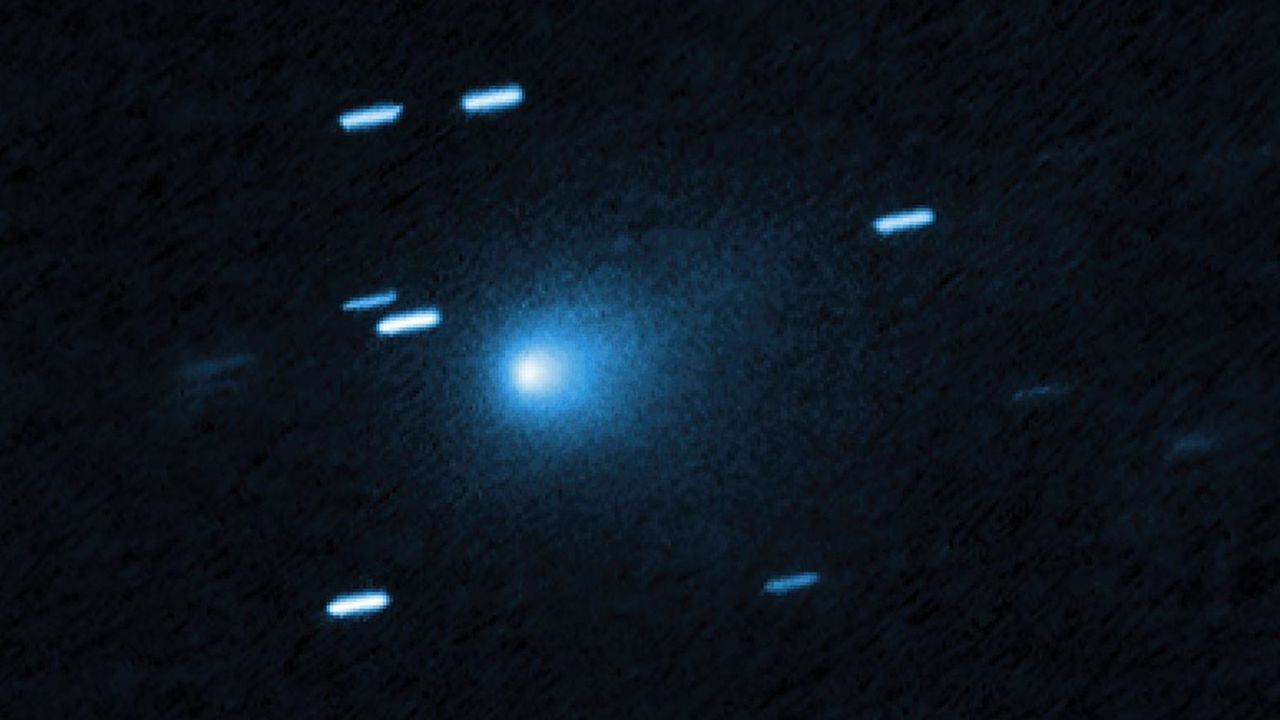Science
Unveiling Nickel in Comet 3I/ATLAS: A Cosmic Discovery

An international research team has made a remarkable discovery involving the interstellar comet 3I/ATLAS, detecting glowing nickel vapor in its surrounding gas. This finding, which occurred at an extraordinary distance from the sun, challenges existing theories about the conditions required for metals to vaporize in space. The comet, first identified on July 1, 2025, presents a unique opportunity to study its chemical composition as it journeys through our solar system.
The comet was detected by the Asteroid Terrestrial-impact Last Alert System (ATLAS), marking it as only the third confirmed interstellar object to be discovered, following the enigmatic ‘Oumuamua and comet Borisov. Unlike its predecessors, 3I/ATLAS was captured early in its approach, allowing astronomers to observe its transformation in real-time as it nears the sun. The significance of interstellar objects lies in their potential to carry chemical and physical information from distant star systems, acting as cosmic time capsules.
Tracking the Chemical Awakening of 3I/ATLAS
The research team, which includes scientists from the Instituto de Astrofísica in Chile and Michigan State University, utilized the Very Large Telescope (VLT) to observe 3I/ATLAS. Their measurements revealed a trajectory suggesting that the comet formed billions of years ago, potentially predating our own solar system.
Initial observations of the comet’s atmosphere showed spectral lines consistent with atomic nickel vapor on July 20, 2025, at a distance of 3.88 astronomical units (AU) from the sun. This detection was unexpected, as temperatures at such distances are typically too cold for metals to vaporize. As the comet approached the sun, the amount of nickel vapor detected increased significantly, indicating a noteworthy chemical activation process.
By mid-August, when the comet reached approximately 3.07 AU from the sun, the team identified the presence of cyanogen (CN) gas, a common emission found in solar system comets. This series of observations illustrates the comet’s transition from a dormant state to one of increased chemical activity.
Implications of Nickel Detection
The detection of nickel without a corresponding presence of iron raises intriguing questions about the chemical processes at work in 3I/ATLAS. The findings suggest that nickel may be released from specific molecular structures that disintegrate under solar radiation, rather than through the usual sublimation process. This could imply that nickel atoms are bound within compounds that release them at lower temperatures, possibly involving interactions with carbon monoxide or other organic materials.
Additionally, observations from the James Webb Space Telescope (JWST) have provided further context. The comet’s coma was found to contain a higher ratio of carbon dioxide to water compared to most solar system comets, along with water ice particles and carbon monoxide gas. These findings support the hypothesis that the nickel in 3I/ATLAS is released through chemical reactions involving complex molecular interactions.
As 3I/ATLAS approaches its closest point to the sun, known as perihelion, on October 29, 2025, researchers are eager to gather more data on its chemical signatures. The ongoing research has implications for understanding whether the building blocks of planetary systems are consistent throughout the galaxy or vary significantly among different stellar environments.
The collaborative effort of scientists from various countries, including Chile, Belgium, the UK, Canada, New Zealand, the United States, and Italy, underscores the global interest in this celestial phenomenon. The team anticipates that as temperatures rise, additional chemical species may emerge, offering new insights into the nature of this ancient interstellar object.
Through methodical research and observation, the investigation of 3I/ATLAS reveals profound complexities in our understanding of cosmic materials. The universe continues to present surprises, reinforcing the importance of evidence-based science in uncovering the mysteries of the cosmos.
-

 Business1 week ago
Business1 week agoIconic Sand Dollar Social Club Listed for $3 Million in Folly Beach
-

 Politics2 weeks ago
Politics2 weeks agoAfghan Refugee Detained by ICE After Asylum Hearing in New York
-

 Health2 weeks ago
Health2 weeks agoPeptilogics Secures $78 Million to Combat Prosthetic Joint Infections
-

 Science1 week ago
Science1 week agoResearchers Achieve Fastest Genome Sequencing in Under Four Hours
-

 Lifestyle2 weeks ago
Lifestyle2 weeks agoJump for Good: San Clemente Pier Fundraiser Allows Legal Leaps
-

 Health2 weeks ago
Health2 weeks agoResearcher Uncovers Zika Virus Pathway to Placenta Using Nanotubes
-

 World2 weeks ago
World2 weeks agoUS Passport Ranks Drop Out of Top 10 for First Time Ever
-

 Business2 weeks ago
Business2 weeks agoSan Jose High-Rise Faces Foreclosure Over $182.5 Million Loan
-

 Science2 weeks ago
Science2 weeks agoMars Observed: Detailed Imaging Reveals Dust Avalanche Dynamics
-

 Entertainment2 weeks ago
Entertainment2 weeks agoJennifer Lopez Addresses A-Rod Split in Candid Interview
-

 World2 weeks ago
World2 weeks agoRegional Pilots’ Salaries Surge to Six Figures in 2025
-

 World2 weeks ago
World2 weeks agoObama Foundation Highlights Challenges in Hungary and Poland









